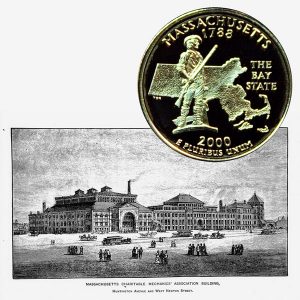Today, the Massachusetts State Quarter Coin remembers when the foreign exhibition opened in Boston on September 3, 1883, which happened to be the centennial of the signing of the peace treaty.
From the Portland [ME] Daily Press of September 4, 1883:
=====
Opening of the Foreign Exhibition at Boston.
Speeches by Prominent; Men, Boston, Sept. 3.—The opening of the foreign exhibition took place here at noon to-day in the building of the Massachusetts Charitable Mechanics Association on Huntington avenue.
The doors were opened some time before the formal opening at noon. A crowd of one thousand or more filled the floor and galleries and that end of the building where the exercises took place.
There were many persons of foreign nationalities present besides numerous members of the State and city government.
At two minutes past twelve the president of the executive committee, Nathaniel Bradlee, escorted upon the platform Rev. E. A. Horton of the Second church who was to deliver the opening prayer.
Music was furnished by the Victoria Rifle Band of some fifty pieces.
Prominent persons followed Mr. Bradlee upon the platform. Among them were Secretary of the Navy Chandler, Lieutenant Governor Ames, Hon. G. B. Luring, C. F. Adams, Jr., W. W. Rice, Mayor Palmer, ex-Gov. Rice, H.B. Pierce and Marshal P. Wilder.
After prayer by Mr. Horton, Hon. Nathaniel J. Bradlee began a speech, making allusion to the signing of the treaty of peace which ended the war with Great Britain Sept. 3, 1783, and the grand results which have been achieved the past one hundred years.
Hon. John Jay of New York, sketched the history of the negotiations for peace, and read tributes paid our commissioners by statesmen and historians.
Charles Francis Adams, Jr., called attention to the fact that the 3d of September was the anniversary of the battle of Dunbar and Worcester, and of Cromwell’s death.
In opening this exposition on this date, it is a blessed centennial of peace that we commemorate.
For the United States, Hon. W. Chandler responded, congratulating the foreign visitors that they had come to a city as enterprising and hospitable as Boston, and welcoming them to America on behalf of the government of the United States.
Lieutenant Governor Ames spoke briefly for the commonwealth.
Ex-Governor Rice said he was called upon to do two important things, to speak in the place of one of the most illustrious sons of Massachusetts, Robert C. Winthrop, and to extend to people of all parts the hearty welcome which Massachusetts gave them.
Commerce and agriculture were the agents of civilization of human brotherhood.
Mayor Palmer said the time and place of the exhibition were peculiarly appropriate. On the three-hilled city of Boston industrial arts had found a nursery, music a home.
Boston had had many things unique and this festival of industry and art was not the least of them. The exhibition was the kindergarten of nations, the academy of arts and labor.
The crowned heads of Europe were present, for labor industry and art there were the crowned heads of the nineteenth century.
Hon. Marshall Philder, the oldest merchant in active business in Boston spoke briefly.
J. Duval the vice president of the Paris Municipal Council spoke in French, and also E. Haas, Commissioner from Germany, in his native language, and A Capel made an eloquent address in English and alluded to the fraternal spirit spreading among the nations, of the faith which he represented.
He was heartily applauded.
Mr. Hookage, Commissioner from Japan, Loo Wen Shib, from China, and Der Lebariave of Panama spoke in their native tongues, acknowledging their obligation.
Mons. Caubert of Paris, Mr. Cortes, the Hawaiian Commissioner, spoke in the same vein.
The speakers were often applauded.
The audience doubled before the exercises ended. Hundreds of guns were fired in commemoration of the event.
The exhibition was in a much more advanced state today than was anticipated Saturday, although there was considerable vacant floor space. The exhibits set up seemed to be in most cases complete and gave to the floors and galleries a bright and attractive appearance.
The exhibits in the west end where the opening exercises took place were in better shape than in the other portions of the building. They were arranged by nations, the National colors being prettily displayed in front of each country’s exhibit.
Brazil, Japan, Spain, Portugal, Austria, Hungary, Algiers, Holland, Sweden, Norway, Belgium, Denmark, Russia, Persia, Turkey, Siam, Cuba, Tunis and Hawaii, were the countries represented in the first hall.
The display consisted largely of fabrics, especially carpets, porcelain and pottery. Some very fine Japanese pottery is shown from the works in Tokio and Anita.
There is also terra-cotta ware from Copenhagan, chinque ware and rough pottery from Mexico, Spain, and Portugal.
Between the two halls is the art gallery which contains very good, though not very many pictures.
Among them is one painted by the Princess Louise.
There are remarkable tapestries on exhibition and a few fine pieces of statuary.
In the east hall are exhibits of China, England, France, Germany, Columbia and the East lndes.
=====
The Massachusetts State Quarter Coin shows with an artist’s image of the Massachusetts Charitable Mechanics Association exhibition hall, circa late nineteenth century.
